The Intel Core i9-9990XE Review: All 14 Cores at 5.0 GHz
by Dr. Ian Cutress on October 28, 2019 10:00 AM ESTCPU Performance: Encoding Tests
With the rise of streaming, vlogs, and video content as a whole, encoding and transcoding tests are becoming ever more important. Not only are more home users and gamers needing to convert video files into something more manageable, for streaming or archival purposes, but the servers that manage the output also manage around data and log files with compression and decompression. Our encoding tasks are focused around these important scenarios, with input from the community for the best implementation of real-world testing.
All of our benchmark results can also be found in our benchmark engine, Bench.
Handbrake 1.1.0: Streaming and Archival Video Transcoding
A popular open source tool, Handbrake is the anything-to-anything video conversion software that a number of people use as a reference point. The danger is always on version numbers and optimization, for example the latest versions of the software can take advantage of AVX-512 and OpenCL to accelerate certain types of transcoding and algorithms. The version we use here is a pure CPU play, with common transcoding variations.
We have split Handbrake up into several tests, using a Logitech C920 1080p60 native webcam recording (essentially a streamer recording), and convert them into two types of streaming formats and one for archival. The output settings used are:
- 720p60 at 6000 kbps constant bit rate, fast setting, high profile
- 1080p60 at 3500 kbps constant bit rate, faster setting, main profile
- 1080p60 HEVC at 3500 kbps variable bit rate, fast setting, main profile
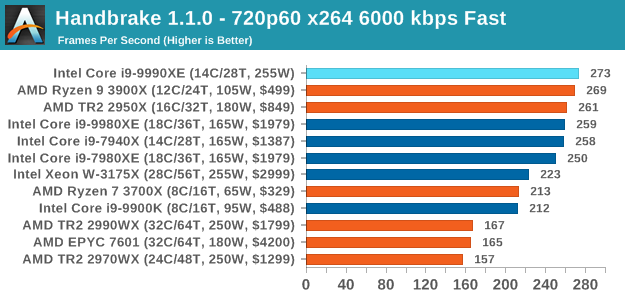
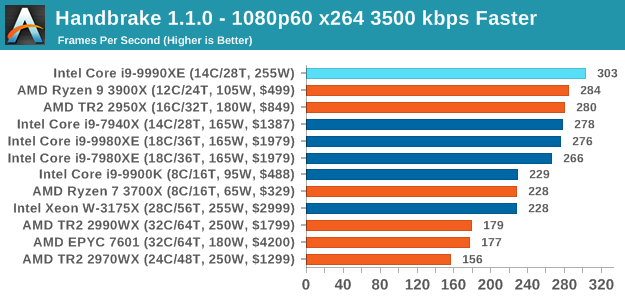
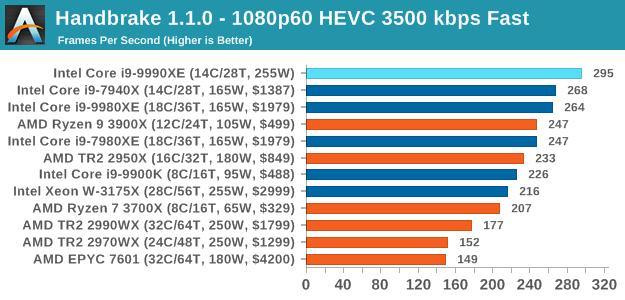
Our encoding tests require a good balance of cores and frequency, and the 5.0 GHz 14-core hardware easily pulls ahead of the 7940X, and shows that having 28 cores isn't always a good thing.
7-zip v1805: Popular Open-Source Encoding Engine
Out of our compression/decompression tool tests, 7-zip is the most requested and comes with a built-in benchmark. For our test suite, we’ve pulled the latest version of the software and we run the benchmark from the command line, reporting the compression, decompression, and a combined score.
It is noted in this benchmark that the latest multi-die processors have very bi-modal performance between compression and decompression, performing well in one and badly in the other. There are also discussions around how the Windows Scheduler is implementing every thread. As we get more results, it will be interesting to see how this plays out.
Please note, if you plan to share out the Compression graph, please include the Decompression one. Otherwise you’re only presenting half a picture.
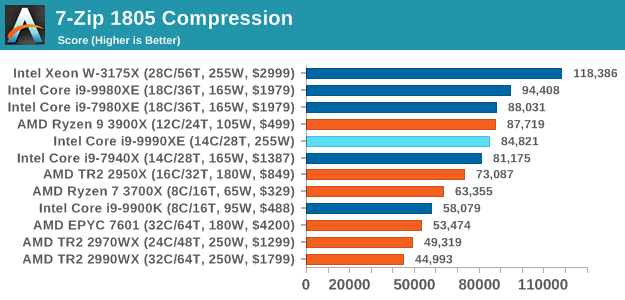
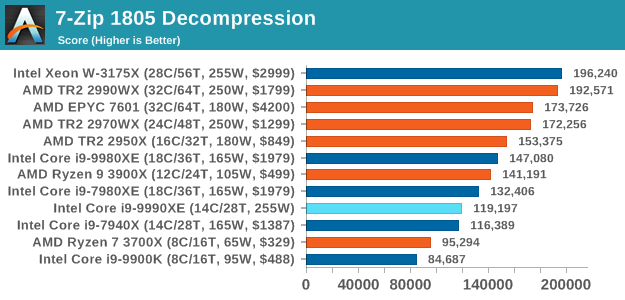

This is where having 28-cores helps, as the extra frequency can't beat some extra cores.
WinRAR 5.60b3: Archiving Tool
My compression tool of choice is often WinRAR, having been one of the first tools a number of my generation used over two decades ago. The interface has not changed much, although the integration with Windows right click commands is always a plus. It has no in-built test, so we run a compression over a set directory containing over thirty 60-second video files and 2000 small web-based files at a normal compression rate.
WinRAR is variable threaded but also susceptible to caching, so in our test we run it 10 times and take the average of the last five, leaving the test purely for raw CPU compute performance.
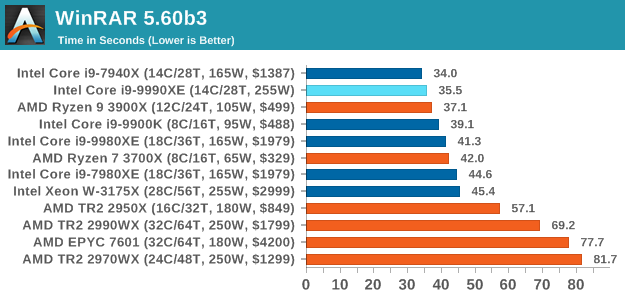
WinRAR is one of our variable threaded tests, so here a mix of cores and frequency helps. Interestingly enough, the 9990XE despite with the higher frequency is slightly slower than the 7940X - this might be a function of the test getting too fast, or the fact that the extra power needed to drive up the cores to peak frequency might be causing additional delays with all the small files.
AES Encryption: File Security
A number of platforms, particularly mobile devices, are now offering encryption by default with file systems in order to protect the contents. Windows based devices have these options as well, often applied by BitLocker or third-party software. In our AES encryption test, we used the discontinued TrueCrypt for its built-in benchmark, which tests several encryption algorithms directly in memory.
The data we take for this test is the combined AES encrypt/decrypt performance, measured in gigabytes per second. The software does use AES commands for processors that offer hardware selection, however not AVX-512.
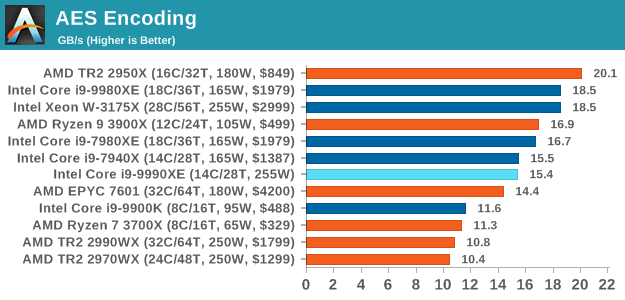










145 Comments
View All Comments
edzieba - Thursday, October 31, 2019 - link
An ASIC has a significant (many months to years) lead time between "we need X design" and functioning silicon. Trading algorithms are a constant arms race being updated to counter others' algorithm changes (who then counter your counters, etc) on the days to hours timescales.shtldr - Tuesday, October 29, 2019 - link
If you've got all the money (which you should, in case you are a successful algorithmic trader), why not go ASIC?Dribble - Monday, October 28, 2019 - link
It's not as simple as you need hundreds of threads or you need one. Compiling is an obvious example. You have a mixture of tasks - some take more threads (e.g. you have a large number of files in a makefile you can compile at once), some take less threads (you have a smaller makefile with only a few files), some take one thread (you need to link).A chip like this with 14 cores and very high single thread performance it turns out is ideal for this sort of task.
Compiling is very much not a niche market.
eek2121 - Monday, October 28, 2019 - link
Word (in the article) is that it helps with web browsing as well. So there is that. ;)That being said, I don't look at this CPU as being competitive to AMD offerings simply because you can't buy the thing. However it is nice to see that Intel can do something if they put their mind to it.
bananaforscale - Thursday, October 31, 2019 - link
Well, multiple cores *do* help with web browsing, doesn't mean you need 14@5 GHz. :DMattZN - Tuesday, October 29, 2019 - link
You don't need all those cores running on a single platform to do HFT. In fact, that winds up being a negative because all the cores are competing for memory cycles. Instead what you want to do is mirror (not split, but do a full mirror) the packet stream to a whole bunch of platforms with fewer cores which can then maximally leverage their memory bandwidth and CPU caches. You also filter the packets inside the NIC itself, not with the CPU.You also don't need to have a high-frequency CPU to minimize response time. The CPU is calculating outcomes from likely moves way ahead of time, long before actually receiving any packet telling it what movement actually happened. When the packet comes in, the CPU really only needs to look up the appropriate response from a table that has already been calculated. In fact, the NIC itself could do the table lookup for certain actions and bypass the CPU entirely.
So you want lots of cores, but they don't actually have to be ultra fast. Anyone using something like this processor to try to 'get ahead' in the HFT game is going to be in for a big surprise.
-Matt
Spunjji - Wednesday, October 30, 2019 - link
Thanks for the clarification. I thought that leaning on a single, many-core high-frequency CPU for this sort of task sounded a lot like optimising the wrong part of the whole process.peevee - Monday, October 28, 2019 - link
That's the point. It does not make them much money, the volume is simply not there. It is for INTEL's bragging.eek2121 - Monday, October 28, 2019 - link
They likely auction the chips due to the aggressive binning required. I expect if they could roll out this kind of chip easily, they would have already. Think: 10 chips for every 100,000 can do 4-5 GHz @ 14 cores, 255 watt TDP.lazarpandar - Monday, October 28, 2019 - link
So if you have an absurd amount of money and can't scale with more cores beyond 14...What a stupid product.